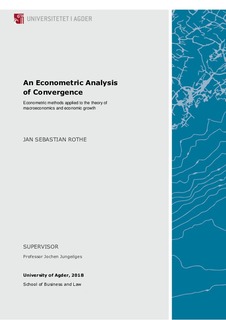| dc.contributor.author | Rothe, Jan Sebastian | |
| dc.date.accessioned | 2018-09-12T09:31:47Z | |
| dc.date.available | 2018-09-12T09:31:47Z | |
| dc.date.issued | 2018 | |
| dc.identifier.uri | http://hdl.handle.net/11250/2562192 | |
| dc.description | Master's thesis Business Administration BE501 - University of Agder 2018 | nb_NO |
| dc.description.abstract | This master thesis explores the concept of convergence in a macroeconomic perspective and applies econometric methods to economic growth theory.
Tests and analysis are performed using a dataset of national accounts from the rich database of The Penn World Tables version 9.0 and the statistical software Stata 15.1. Two sample selections are performed, with observations for 101 and 53 countries from 1970 to 2014.
The convergence classifications of β convergence, both absolute and conditional, as well as σ convergence are explained. The concepts of convergence are related to their respective research question. Do poorer economies tend to grow faster than richer economies? Do inequalities between poorer economies and richer economies tend to decrease? Do economies converge towards a common or unique steady state? Macroeconomic and economic growth theory is discussed and explained through neoclassical growth theory and new growth theory. The Solow model from neoclassical growth theory and the R&D model from new growth theory are mathematically derived and empirically tested to explore the dynamics of economic growth and to answer the question of the concept of absolute convergence. Other applied tests are growth-initial level regressions, which tests for β convergence, and standard deviation time series, which tests for σ convergence.
The research provides empirical evidence that poorer economies do tend to grow faster than richer economies, but with unreliable results due to issues of non-normality and heteroscedasticity. Empirical evidence also suggests that income dispersion of OECD countries is steadily increasing and that income dispersion of the full sample of 101 countries decreased from 1970 to 1988. The standard deviation time series test does not give a conclusive answer for the full sample after 1988. Due to issues of heteroscedasticity and autocorrelation, generalized least squares method is used to give the best linear unbiased estimator of the parameters of the Solow model. Empirical evidence show that capital’s share is 60% and not 1/3 as the theory suggests. By adding human capital as in the theory of the augmented Solow model, empirical evidence shows a much lower capital’s share of 20%. Individual heterogeneity suggests that countries follow unique paths to their own equilibrium level of economic growth given the parameters of the Solow model.
The resulting evidence from the conducted tests and analysis successfully provides satisfactory answers to the research questions of this master thesis. | nb_NO |
| dc.language.iso | eng | nb_NO |
| dc.publisher | Universitetet i Agder ; University of Agder | nb_NO |
| dc.rights | Attribution-NonCommercial-NoDerivatives 4.0 Internasjonal | * |
| dc.rights.uri | http://creativecommons.org/licenses/by-nc-nd/4.0/deed.no | * |
| dc.subject | BE501 | nb_NO |
| dc.title | An Econometric Analysis of Convergence : Econometric methods applied to the theory of macroeconomics and economic growth | nb_NO |
| dc.type | Master thesis | nb_NO |
| dc.subject.nsi | VDP::Samfunnsvitenskap: 200::Økonomi: 210 | nb_NO |
| dc.source.pagenumber | 77 p. | nb_NO |

